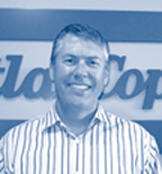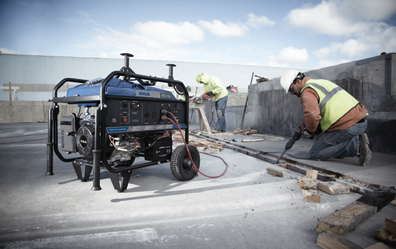Industry Outlook: Generators
Across-the-board improvements increase value for your customers
By Mike Martin
|
|
It may be time to assess your generator line-up. Input from several generator manufacturers shows some consistent improvements in quality, efficiency, ease-of-use and, of course, upgrades to Tier 4 Final engines. Whether your customers need a portable system to carry or roll to its needed destination, or a towable system to power a complete construction site, it’s worth reviewing the line-up of improved products.
For this article, we asked for input from Kohler, Honda, Kipor, Subaru and Atlas Copco. We wanted to know, from their viewpoints:
- What trends are driving product development?
- How are the manufacturers responding to rental market trends?
- What new technologies or materials are being introduced to improve productivity, reliability and durability to benefit you and your contractor customers?
- What kinds of changes can we expect in the future?
- How can contractor rental houses work more closely with suppliers to introduce products to contractors?
Here’s what they had to say:
 Steve Zielke, Marketing Manager
Steve Zielke, Marketing Manager
Kohler Power Systems
Regarding product development trends - first and foremost, stricter EPA regulations have coincided with environmentally conscientious end- users. This has led to significant improvements in the fuel efficiency and emissions of the engines that power our generators. All new diesel engines must adhere to Tier 4 Final emissions standards, so engine manufacturers have made significant design changes to achieve compliance.
In addition, in parallel with the electronics industry, control interfaces are becoming more intuitive and visual. Users will find operating and monitoring these new generators easier than older models.
Also, as the price of gasoline and diesel fuel has increased, along with the desire for many companies to operate in the most environmentally responsible manner possible, exploring the use of alternative fuels has driven new product development. Propane is widely accepted in the residential heating and electrical market, and it has been used for years to fuel residential standby generators. In recent years it has increased in use as a fuel for portable and towable generators.
Product development is also being driven by the sheer increase in demand for power generation in expanding industries such as natural gas mining and shale exploration, often in remote sites where utility power is not available or can’t support power needs. These new opportunities have led to investment in mobile product development by power generation manufacturers looking to capitalize on market potential.
As a response to this trend, we’re now using our Tier 4 Final Kohler direct injection diesel engine (introduced in 2012) on our just-released mobile generators, ideal for construction sites, remote power in the mining and gas industries, and other temporary power needs. Our Tier 4 Final diesel engine offers greater power density, quiet performance and emissions compliance without the use of a diesel particulate filter, which decreases operating costs.
Our new Decision Maker 3500 controller offers a graphical interface with user-friendly displays and keypad functions, remote monitoring and the capability to parallel two generators for greater power output.
We continue investing in research and design of our products to offer additional fuel source options. Our new mobile generator line includes gaseous models that offer on-board LP tank storage, as well as the capability to easily switch to on-site LP gas, LP liquid and natural gas.
To improve productivity, reliability, durability, we’re using EPA-certified engines for high run times for prime and mobile applications in order to meet in-the-field needs. We’re also applying an existing technology to the mobile power market in redesigning our controller. It now allows paralleling to add a layer of redundancy on sites, and/or incorporate generator management of several smaller units versus one larger unit. This allows the system to cycle generators on and off based on pre-set load requirements. This helps users save fuel at times when less power is needed, it extends maintenance levels and unit life, which benefits rental centers as well as end-users, and helps better manage fleets of power generation systems.
Looking into the future, we’ll continue to invest in expanding our product lines to accommodate alternative fuels that offer environmental benefits, fuel efficiency, lower operating costs, and are in demand in the market. To support these initiatives, the company is investing in many capital-intensive projects to expand and improve our facilities, both domestically and internationally.
How can rental houses work more closely with suppliers to introduce products to end-use customers? The entire supplier, rental and sales process needs to work together to ensure customers can rent the equipment they need, are satisfied and keep coming back.
We need to work together to educate contractors about product options and the benefits of new technology. A supplier focused on strong customer service can be an education and product development partner – especially those equipped with custom engineering services. When available, rental houses should tour supplier facilities so they have a working knowledge of suppliers’ capabilities and core competencies.
Rental houses can also provide real-time, firsthand customer feedback in terms of product features and potential unmet customer needs that can lead to future product innovation. Providing suppliers with segmented sales data, for example, helps us create business cases to fund new research and development projects and justify capital investment. Also, we appreciate the opportunity to tour key project sites and talk with end- customers in the field, especially for unique or high-growth markets. This can also promote innovation.
 Sarah Pines, Marketing Communications
Sarah Pines, Marketing Communications
Honda
At Honda Power Equipment, we’ve been seeing customers in the generator marketplace more interested in fuel economy, low cost of operation and reliability. We’ve responded to these market concerns by continuing to strive to produce only generators with class-leading fuel economy and unmatched reliability – all to ensure that generator users have very little product down time or high operational costs. Our latest product is specifically designed to meet these needs: The EU7000is incorporates reliability and durability, along with excellent fuel economy.
We have introduced new generator technology - such as electronic fuel injection - to the new Honda model to increase fuel economy. And it’s equipped with a 5.1 gallon gas tank and can operate for six hours per tankful at rated load or an estimated 18 hours at one-quarter load. This allows the generator to achieve a 25 percent increase in run time and a 20 percent increase in fuel economy over comparably sized/output units. The new generator also has a separate, triple-chamber construction - an exhaust [muffler] chamber, an engine chamber and an intake chamber, plus the “Eco-Throttle” design for a noise level of approximately 60 dB at rated load – resulting in quiet operation.
Looking down the road, Honda expects to see additional focus placed upon fuel economy and quiet operation; both are key purchase reasons for generator buyers and renters. Although we can’t specifically discuss future product development at our company, it is fair to expect that new Honda generators will include these two attributes.
To help introduce new products to contractor customers, look for and leverage supplier point of purchase materials. They should help staff more easily explain and highlight the features and benefits of the various product lines to rental customers.
 Jerry Fife, Director of Sales and Operations
Jerry Fife, Director of Sales and Operations
Kipor Power Equipment Inc.
The trends we see driving product development are cost, dependability and product support. With the number of storms and disasters over the last couple of years, people realize that having some type of backup power is a necessity, not just a convenience – particularly where consistent power is needed to run important equipment, whether for a home or some larger institution. The need for reliable products and product support fits across all market sectors. In the rental market we see a focus and a need for smaller packages that deliver more kW, that are lighter weight and easy to operate.
Our response to this need is to focus on delivering quality inverter generators. The advantage of using an inverter generator is that it is, lighter weight, more fuel efficient, quieter and delivers pure clean sine-wave products that can power sensitive electronic equipment. We’ve developing larger portable generators to support the demands for more power in a portable package. As part of this, in terms of the technology, we focus on improved manufacturing and testing processes that result in improved reliability and dependability. In the future, customers can expect to see ease-of-operation features, easier starting, quiet running and lighter weight models.
To help introduce products to end-use customers, we see feedback from rental centers and from their customers as very important. Every market and many regions are different in terms of what they need and what works best in their market. Our goal is to support the rental market with the most perfectly matched product for their needs.
 Jim Siffring, Product Manager, Generators
Jim Siffring, Product Manager, Generators
Atlas Copco Construction Equipment
Emission requirements and the move to Tier 4 Final capture most of the limelight, but there are several other trends driving product development, including fuel autonomy or run time, rental
flexibility, reliability, ease of portability and increased maintenance intervals, that are also gaining attention.
We’re responding to trends with our promise of “Sustainable Productivity,” which relates to many things. We are constantly improving our emission levels, which includes Tier 4 Final development of all our generator products. With 110% spill containment, we can assure end-users that they don’t have to be concerned with hazardous fluid spills, and we have confidence there will be no harm to sensitive soils or water. We are continually striving to improve our products in terms of increasing reliability and maintenance intervals, expanding flexibility beyond altitude and decreasing temperature constraints. All of these factors improve the user’s productivity.
For new technologies or materials, we’ve been integrating poly tanks into our products for some time now. These offer many advantages, including decreased fuel contamination due to corrosion and condensation ingress and increased reliability of the tank itself. We have also integrated DeepSea controllers throughout our small and medium (25kVA – 330kVA) product lines.
In our large generator range, we have introduced the QAC 1200 for U.S. and Canadian markets. This package design is based on a standard 20’ ISO shipping container but is far more robust and specifically designed and manufactured to be a generator enclosure - not just a re-fitted shipping container. We have many new and innovative technologies unique to this unit. It is perfect for severe service applications, such as rental, petroleum and mining.
For the future, technology continues to evolve and improve in engine, emission and generator controls. These newer and more developed solutions will become seamless and as easy to live with as any other part of the genset.
In terms of the supplier/rental house relationship, it’s critical that rental houses relay ideas, needs, wants and requests to their local Atlas Copco reps so that we can relay them to our engineers. There are many good ideas, and they often come from the folks who are renting and using the equipment on a daily basis. Some of the best improvements start with a conversation that begins with the simple question: “You know what would be really neat?” We have a large staff of reps that visit rental houses every day. When you see one, let them know your ideas or what you are hearing from your customers. If you aren’t seeing a rep, call us, we’ll have one come by!
 Pam Meyer, Equipment Sales Manager
Pam Meyer, Equipment Sales Manager
Subaru
With the rash of storms and emergency situations the past few years, the rental industry and dealers across the country are seeing the value in being well stocked in generators. In addition, the manufacturers recognize the need to drive safety and ease of use in their generator designs. Generators have a broad range of applications, so it’s critical that dealers know what to recommend. Understanding the different applications and how each generator fits makes for a happy customer and a successful dealer.
Subaru has always been focused on listening to the voice of the customer and responding to customer needs and market trends with the appropriate designs. This started with the development of our SGX line when we saw the need in the market for a generator that fell between the “throw away” consumer models and the high-end premium models. This line really has all the basic features that a moderate industrial user would need, such as an automatic voltage regulator (AVR) system for precise voltage control output, a low-tone muffler and a two-wheel kit for enhanced portability.
We continued that responsiveness by incorporating features that help make our generators easier to service and maintain. This includes a low oil-level sensor with automatic shutoff and an hour meter for scheduling maintenance. This is important in the rental market because of varied users and the need to have the equipment on site and operating in order for the rental center to make money. Options like our washable foam air filters further decrease the costs associated with maintenance.
The maintenance and service features certainly increase reliability and durability. Furthermore, features Subaru Industrial Products has incorporated into the SGX and RGX lines, like GFCI circuits and twist lock receptacles, help end-users be more productive and remain safe on the job site.
As far as future products, Subaru is in the process of testing a new line of generators. This new line will continue to advance the ease of service and maintenance, key concerns for both rental and end-users/owners.
As far as introducing generators to customers, the most crucial elements to success with generators are, first, truly understanding how they work, and second, understanding what the customer really needs. Many manufacturers have a wealth of information available on their websites and offer training seminars that will help rental centers and dealers better understand how the generators can meet their needs and their customer needs. In addition, at Subaru, we are always available. A simple call and we can walk someone through the questions to ask and how to end up at the right recommendation for the customer. Key considerations include sizing a generator, startup and continuous wattages, tune-up and maintenance tips, as well as basic safety and operation.
Originally published in the May/June 2014 issue of Pro Contractor Rentals. Copyright 2014 Direct Business Media.









